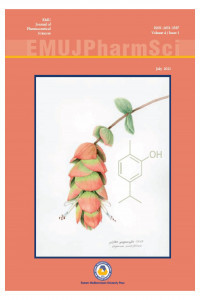Oleuropein amounts of olive leaves from different regions of Northern Cyprus
Oleuropein amounts of olive leaves from different regions of Northern Cyprus
Olea europea oleuropein, HPLC,
___
- Anza M, Bibiso M, Alemayehu B, Desalegn E (2017). Phytochemical analysis, in vitro antioxidant and antibacterial activities of root extracts of Carduus macracanthus. J Coast Life Med 5(11): 486-491.
- Czerwińska ME, Duszak K, Parzonko A, Kiss AK (2016). Chemical composition and UV a-protecting activity of extracts from Ligustrum vulgare and Olea europaea leaves. Acta Biol Cracoviensia Series Botanica 58(2): 45–55.
- European Pharmacopoeia 8th edition, p. 1337, 2014.
- Hayes JE, Allen P, Brunton N, O’Grady MN, Kerry JP (2011). Phenolic composition and in vitro antioxidant capacity of four commercial phytochemical products: Olive leaf extract (Olea europaea L.), lutein, sesamol and ellagic acid. Food Chem 126(3): 948-955.
- Kapellakis IE, Tsagarakis KP, Crowther JC (2008). Olive oil history, production and by-product management. Rev Environmental Sci and Bio/Technol 7(1): 1-26.
- Qin S, Hou D (2017). The Biofunctions of Phytochemicals and Their Applications in Farm Animals: The Nrf 2/Keap1 System as a Target. Engineering 3: 738–752.
- Talhaoui N, Taamalli A, Gómez-Caravaca AM, Fernández-Gutiérrez A, Segura-Carretero A (2015). Phenolic compounds in olive leaves: Analytical determination, biotic and abiotic influence, and health benefits. Food Res Inter 77(2): 92-108.
- Talhaoui N, Vezza T, Gómez-Caravaca AM, Fernández-Gutiérrez A, Gálvez J, Segura-Carretero A (2016). Phenolic compounds and in vitro immunomodulatory properties of three Andalusian olive leaf extracts. J Functional Foods 22:270–277.
- Vinha AF, Ferreres F, Silva BM, Valentão P, Gonçalves A, Pereira JA, Oliveira MB, Seabra RM, Andrade PB (2005). Phenolic profiles of Portuguese olive fruits (Olea europaea L.): Influences of cultivar and geographical origin. Food Chem 89(4): 561-568.
- ISSN: 2651-3587
- Başlangıç: 2018
- Yayıncı: Doğu Akdeniz Üniversitesi
Oleuropein amounts of olive leaves from different regions of Northern Cyprus
Plant biodiversity and unique yew stands of Istranca (Yıldız) mountains in European Turkey
Mehtap OZTEKİN, F. Neriman ÖZHATAY
The metabolites of ellagitannin metabolism urolithins display various biological activities
Jale YUZUGULEN, Bahareh NOSHADİ, Karar SHUKUR, Mustafa Fethi SAHİN, Hayrettin Ozan GULCAN
Forced degradation studies of new formulation containing naltrexone
Golnaz YAGHOUBNEZHADZANGANEH, E. Vildan BURGAZ
